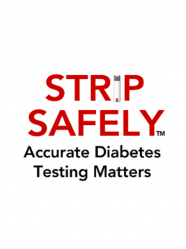Write Congress and Urge the FDA to Ensure Glucose Test Strips Meet Accuracy Requirements

StripSafely is a new advocacy campaign that encourages people with diabetes and caregivers to write Congress and push the FDA on an important issue: glucose test strip accuracy. You can read all the details at http://www.stripsafely.com and follow @StripSafely on Twitter; the program urges the FDA to:
1) Perform ongoing tests of blood glucose strips to assure compliance with regulatory accuracy and quality standards. Currently, glucose test strips are only tested before approval, and these tests are done by the manufacturers themselves – it would be great to have an independent body test quality and accuracy on an ongoing basis;
2) Tighten blood glucose meter accuracy standards to ensure that strips are more accurate than the current requirements. The International Standards Organization (ISO) just recently adopted a tighter accuracy standard, though the FDA has not yet adopted it. The current US standard is looser than the new ISO Standard* and the field has been waiting for years for tighter standards to be announced.
3) Impose penalties and/or remove inaccurate strips from the market. Currently, the FDA does not have a mechanism to make this happen, unless a product is recalled.
We think this is a critical issue, especially with the recent 68% price cut in the amount Medicare will pay for glucose strips. In our view, this change will hurt patients in the long run. First, it could mean that unproven and potentially lower-quality manufacturers will become the primary suppliers of test strips for people with diabetes on Medicare. Private insurance providers could follow in Medicare’s footsteps and adopt these changes, which could mean limited choices for all patients. Second, the dramatic price cuts stand to reduce the ability of companies to develop next-generation, advanced glucose testing products. We hope the decision is a not permanent, as we also do not see it significantly benefitting healthcare expenditures in the long term (i.e., most healthcare expenditures on diabetes in the US go to hospital visits and services, not to technologies like glucose meters and strips). –AB
*For background, the FDA currently uses the 2003 ISO Standard, which requires that 95% of all measurements be within 20% of the lab value for values above 75 mg/dl or within 15 mg/dl of the lab value for values under 75 mg/dl.
In April 2013, ISO adopted new stricter accuracy standards, which require 95% of all measurements to be within 15% of the lab value for blood glucose measurements above 100 mg/dl and within 15 mg/dl for values under 100 mg/dl. Additionally, 99% of blood glucose values must fall within zones A and B of the Consensus Error Grid (CEG) for type 1 diabetes. The CEG defines different “zones” of error and how much that error could cause the person to make a treatment decision that could be dangerous.







